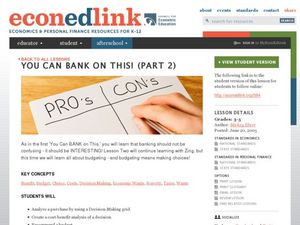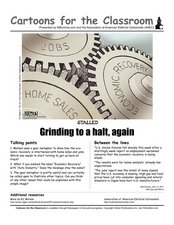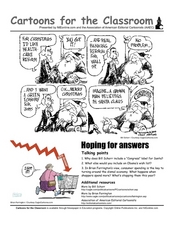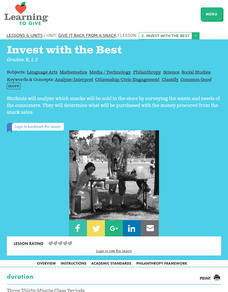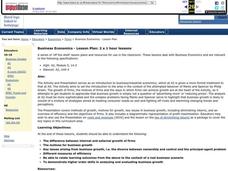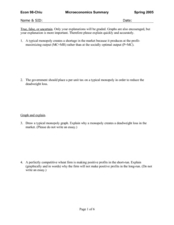Council for Economic Education
You Can BANK on This! (Part 2)
This is part two in a four-part instructional activity on banking and personal finance. In this instructional activity, learners analyze whether or not they have made a good purchase, then discuss how to make an informed decision about a...
University of Nebraska
Why Do I Want All This Stuff?
How do advertisers influence consumers? The big idea here is that once consumers understand the factors that influence their desire for a product or service, they are better able to consider substitute and/or complementary products.
Japan Society
The Bubble Economy and the Lost Decade
Explore Japanese society and national identity. Class members share ideas about the Japanese economy and then investigate a series of resources, including an article, a film, a lecture, and a poem, to learn about Japan's Bubble Economy...
Curated OER
Homer Price
An engaging and unique activity that combines literature and economics is here for you. In it, learners read the short story, "The Doghnuts" found in the book Homer Price. Pupils define "capital resources," and utilize a worksheet...
Curated OER
What is Biotechnology?
Young consumers explore the concept of biotechnology as it pertains to the foods they eat, economics, and agriculture. They watch several videos, explore a website, complete worksheets, and engage in class discussion. Son they'll know...
School Improvement in Maryland
Regulatory Agency
Five governmental regulatory agencies are tasked to respond to market failure. Groups investigate the roles of each of these agencies as well as the social, economic, and political impact of their actions.
EduGAINs
Consumerism, Me and the Natural Environment— Canadian and World Studies
Just as no man is an island, no country is totally independent of other countries. To understand the impact of individual consumer decisions on the global natural environment, class groups consider how the stuff they...
Curated OER
Calculating the Cost of Living
Bring Consumer Mathematics and Economics to life with this lesson, where learners investigate personal finance and budgeting. They use the newspaper’s classified section to determine a future job and potential earnings and determine a...
Curated OER
Cartoons for the Classroom: Grinding to a Halt- The U.S. Economy
Using gears as a visual metaphor, this political cartoon analysis worksheet gives a clear picture of one artist's perspective on the U.S. economy. Background information helps give pupils access to the cartoon's context, and 3 talking...
Curated OER
Pet Food Safety a Concern
Students research pet food safety laws to find out what is required in general, explore what fellow students consume, consult with veterinarian about what he or she thinks about pet food safety, present findings to classmates, and...
Curated OER
Hopeful Eyes on Southern Skies
The Times covered a drought in 2011, which affected producers, consumers, and sellers. The class gets informed about climate and the economics of agriculture as the read this article and answer each of the 11 comprehension questions. A...
Math Solutions
Cooking Up Chicken
Although designed for career education classes by the Chicken Farmers of Saskatchewan, the information contained in this 46-page booklet is appropriate for cooking classes and individual chicken consumers. Everything you wanted to...
Deliberating in a Democracy
Globalization and Fair Trade
Have you ever traded something? How do you know you got a good deal? Scholars use case studies and research to determine the role of globalization in fair trade. Class members examine consumer demand and competition bring to light the...
Curated OER
Evaluating Information on Food Labels
What kinds of foods include corn? Corn syrup? Start by viewing a clip of Food Inc. with your middle or high schoolers. Then, study a list of corn-derived ingredients, encouraging your class to see how many food products contain corn. A...
Curated OER
Bottled Water Ban
Convenience, taste, portability ... what's not to love about bottled water? Apparently, a lot. Scholars analyze the four main arguments supporting and opposing the sale of bottled water. They explore the health, environmental, and...
Curated OER
Cartoons for the Classroom: Congress and the President
Learners take a critical look at the ways in which the president interacts with Congress in order to make political and economic decisions. They use a series of well-constructed discussion questions to guide their thinking as they...
Curated OER
In the Eyes of the Beholder
High schoolers investigate the relationship between the consumers and producers with the role that the government plays in the free enterprise system.
Curated OER
Government Lesson Plan 19
Students define vocabulary terms related to monetary policies, and apply monetary tools to solve economic scenarios.
Curated OER
Packaging: What a Waste!
Students examine the environmental and economic impacts of excess packaging. They investigate the price and relative amount of processing and packaging of different food products in a local grocery store, analyze graphs, and complete a...
Curated OER
Give It Back From a Snack Lesson 2: Invest With the Best
Students survey schoolmate as to what type of snacks they would prefer to purchase. They graph the results and apply them to planning a classroom snack sale while examining what wants, needs, and consumers are.
Curated OER
Gross Domestic Product in the Real World
Learners gain knowledge of Gross Domestic Products and how they are used as an economic indicator. They bring articles that mention GDP and decide how it is used in articles. Students present orally their findings to the class.
Curated OER
Business Economics
Students analyze the difference between internal and external growth of firms, and various measures of efficiency. They apply these measures to the context of a real business scenario.
Curated OER
Microeconomics Summary
Twelfth graders study microeconomics. In this Economics lesson, 12th graders draw graphs on government taxes. Students decide if these graphs are true or false.
Curated OER
Pros and Cons of Advertising
Twelfth graders compare and contrast television commercials. They write paragraphs explaining how different company commercials for the same product can confuse consumers.
